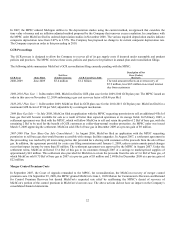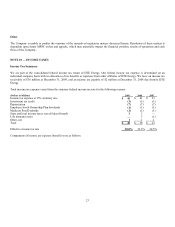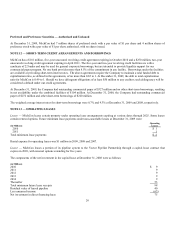DTE Energy 2009 Annual Report Download - page 32
Download and view the complete annual report
Please find page 32 of the 2009 DTE Energy annual report below. You can navigate through the pages in the report by either clicking on the pages listed below, or by using the keyword search tool below to find specific information within the annual report.
30
Net pension costs
Discount rate
6.90%
6.50%
5.70%
Rate of compensation increase
4.00%
4.00%
4.00%
Expected long-term rate of return on Plan assets
8.75%
8.75%
8.75%
At December 31, 2009, the benefits related to the Company’ s qualified and nonqualified pension plans expected to be paid in each of
the next five years and in the aggregate for the five fiscal years thereafter are as follows:
(In millions)
2010 ........................................................................................................................................................................................
$ 40
2011 ........................................................................................................................................................................................
41
2012 ........................................................................................................................................................................................
41
2013 ........................................................................................................................................................................................
43
2014 ........................................................................................................................................................................................
44
2015 - 2019 .............................................................................................................................................................................
240
Total ........................................................................................................................................................................................
$ 449
The Company employs a formal process in determining the long-term rate of return for various asset classes. Management reviews
historic financial market risks and returns and long-term historic relationships between the asset classes of equities, fixed income and
other assets, consistent with the widely accepted capital market principle that asset classes with higher volatility generate a greater
return over the long-term. Current market factors such as inflation, interest rates, asset class risks and asset class returns are evaluated
and considered before long-term capital market assumptions are determined. The long-term portfolio return is also established
employing a consistent formal process, with due consideration of diversification, active investment management and rebalancing. Peer
data is reviewed to check for reasonableness.
The Company employs a total return investment approach whereby a mix of equities, fixed income and other investments are used to
maximize the long-term return on plan assets consistent with prudent levels of risk, with consideration given to the liquidity needs of
the plan. The intent of this strategy is to minimize plan expenses over the long term. Risk tolerance is established through
consideration of future plan cash flows, plan funded status, and corporate financial considerations. The investment portfolio contains a
diversified blend of equity, fixed income and other investments. Furthermore, equity investments are diversified across U.S. and non-
U.S. stocks, growth and value investment styles, and large and small market capitalizations. Fixed income securities generally include
corporate bonds of companies from diversified industries, mortgage-backed securities, and U.S. Treasuries. Other assets such as
private equity and hedge funds are used to enhance long-term returns while improving portfolio diversification. Derivatives may be
utilized in a risk controlled manner, to potentially increase the portfolio beyond the market value of invested assets and reduce
portfolio investment risk. Investment risk is measured and monitored on an ongoing basis through annual liability measurements,
periodic asset/liability studies, and quarterly investment portfolio reviews.
Target allocations for plan assets as of December 31, 2009 are listed below:
U.S. Large Cap Equity Securities ..............................................................................................................................
25%
U.S. Small Cap and Mid Cap Equity Securities .........................................................................................................
6
Non U.S. Equity Securities .......................................................................................................................................
14
Fixed Income Securities ............................................................................................................................................
26
Hedge Funds and Similar Investments ......................................................................................................................
20
Private Equity and Other ...........................................................................................................................................
6
Short-Term Investments ............................................................................................................................................
3
100%





















